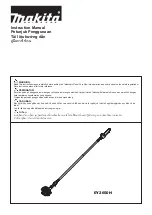
www.scheppach.com /
+(49)-08223-4002-99 /
+(49)-08223-4002-58
GB | 59
d) Push the saw through the workpiece. Do not pull the saw
through the workpiece. To make a cut, raise the saw head and
pull it out over the workpiece without cutting, start the motor,
press the saw head down and push the saw through the work-
piece.
Cutting on the pull stroke is likely to cause the saw blade to
climb on top of the workpiece and violently throw the blade assembly
towards the operator.
e) Never cross your hand over the intended line of cutting either
in front or behind the saw blade.
Supporting the workpiece “cross
handed” i.e. holding the workpiece to the right of the saw blade with
your left hand or vice versa is very dangerous.
f) Do not reach behind the fence with either hand closer than 100
mm from either side of the saw blade, to remove wood scraps,
or for any other reason while the blade is spinning.
The proximity
of the spinning saw blade to your hand may not be obvious and you
may be seriously injured.
g) Inspect your workpiece before cutting. If the workpiece is
bowed or warped, clamp it with the outside bowed face toward
the fence. Always make certain that there is no gap between
the workpiece, fence and table along the line of the cut.
Bent or
warped workpieces can twist or shift and may cause binding on the
spinning saw blade while cutting. There should be no nails or foreign
objects in the workpiece.
h) Do not use the saw until the table is clear of all tools, wood
scraps, etc., except for the workpiece.
Small debris or loose piec-
es of wood or other objects that contact the revolving blade can be
thrown with high speed.
i) Cut only one workpiece at a time.
Stacked multiple workpieces
cannot be adequately clamped or braced and may bind on the blade
or shift during cutting.
j)
Ensure the mitre saw is mounted or placed on a level, firm work
surface before use.
A level and firm work surface reduces the risk
of the mitre saw becoming unstable.
















































